
‘12
Island Ornithology
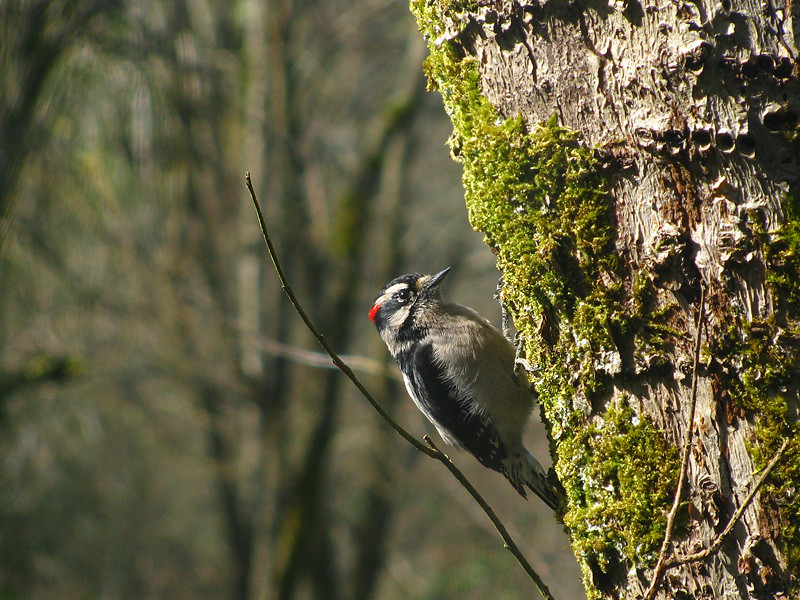
A male downy woodpecker hunts for insects on the Gravenstein apple tree.
Bird watching is a hobby that I came by when it came to me. Living in the city, I enjoyed my chance encounters with more unusual visitors — peregrine falcons roosting in city skyscrapers, for instance — but the crows and pigeons crowding the curbs and wires held no interest for me.
Here on Bainbridge the bird-watching scene is rather different. Of course, we have the birds I grew up with: An extended family of robins perches in the alders and scours the horse pasture; a flock of chickadees sings call-and-response duets with us as we work in the field. The great numbers of these small familiar birds may be an attractant for some of our other guests.
Roosting somewhere on the island are a pair of mated red-tailed hawks, who will swirl and swoop over the farm, sometimes alarmingly close. Although they're supposed to leave chickens alone, we once startled a hawk that had landed and was going after one of our chickens on foot. Note to other hawks: Once you're on the ground, you no longer have much of an advantage.
While feeding the horses at night we've disturbing hunting owls on more than one occasion; it would seem that the field mice and their brethren have purpose beyond keeping our cats entertained. I've only had fleeting glimpses of the owl(s).
I would be remiss if I failed to mention the great panjandrums of the sky — the bald eagles. A pair of eagles shares territory with the red-tailed hawks, soaring over the island waiting for something to catch their eye. At times they'll wing close enough to send our chickens scrambling for cover.
My personal favorites, however, are the retinue of woodpeckers attracted by the Gravenstein apple tree outside my office window. Last autumn, I often saw a red-breasted sapsucker maintaining the rows of holes drilled at intervals around the tree's circumference. A pileated woodpecker found these same holes irresistible shortly afterwards, and just today a downy woodpecker was excavating the hidden insects. I'm charmed by the woodpeckers' stuttering shimmy as they raid the insect caches.
‘12
No Shell, No Problem
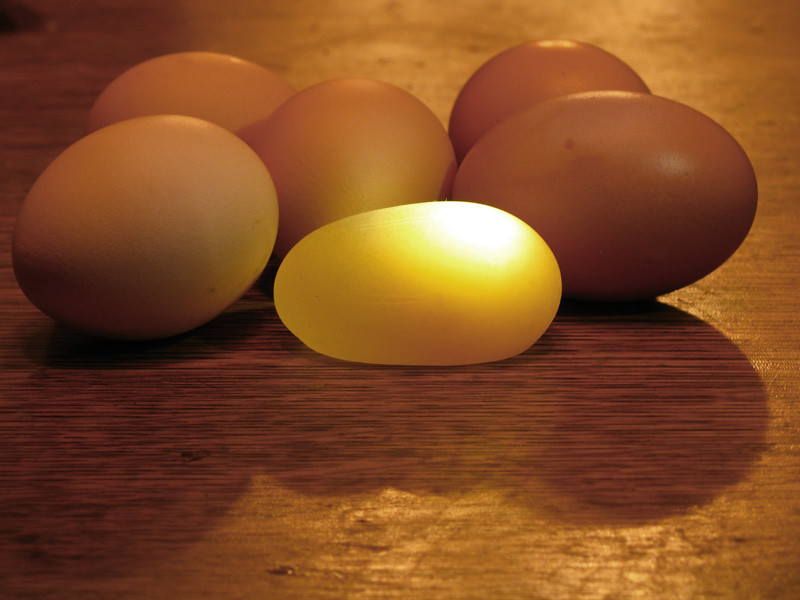
Which of these eggs is not like the others?
As I collected the day's chicken eggs, I found myself incredulous. We keep a few golf balls in each of the nest boxes to remind the chickens that they're a good place for eggs to be laid. As such, I'm accustomed to seeing two things in the nest boxes: golf balls and eggs. I do not expect to see rubbery, translucent egg-shaped objects. The photo above shows how much light diffuses through the egg (using a small spotlight).
After I recovered from my initial surprise and shared my discovery, I was informed that this sort of mistake — an egg without its shell — is not at all unheard of. Such eggs are perfectly safe to eat. On the other hand, we might want to save it to hatch for a new breed of no-shell egg layers.
‘12
Planting Apples
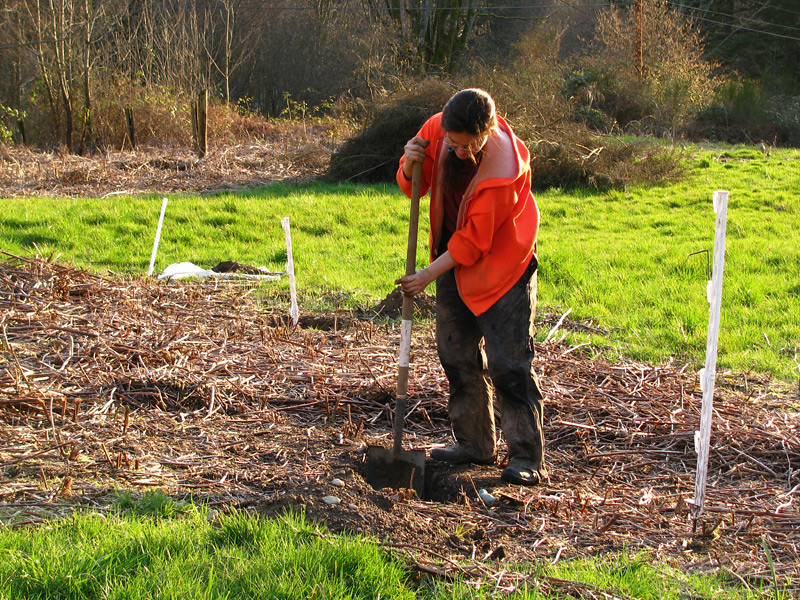
Making enough room for apple roots to spread out.
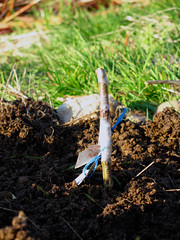 Today the first round of grafted apple trees went in the ground. Calling them trees seems like a bit of an exaggeration — in reality, they're whips, and won't resemble trees for a little while yet. Even when they're fully grown, they won't share the majesty of the trees in the old orchard. The rootstock is Malling 111, which grows to 75-85% the size of a standard tree. And of course, regular pruning will preclude the sort of skyscraping that our King Tree has an inclination towards.
Today the first round of grafted apple trees went in the ground. Calling them trees seems like a bit of an exaggeration — in reality, they're whips, and won't resemble trees for a little while yet. Even when they're fully grown, they won't share the majesty of the trees in the old orchard. The rootstock is Malling 111, which grows to 75-85% the size of a standard tree. And of course, regular pruning will preclude the sort of skyscraping that our King Tree has an inclination towards.
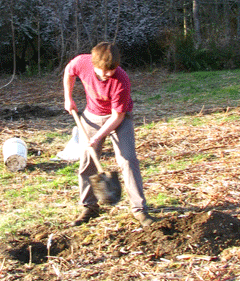 Still, the eighteen trees we planted today are larger than the rest of the year's apples — dwarfing and semi-dwarfing rootstock variants that have yet to sink their roots into loose soil. Most of the trees planted today are heritage apples that trace their lineage back to a family orchard on Vashon Island.
Still, the eighteen trees we planted today are larger than the rest of the year's apples — dwarfing and semi-dwarfing rootstock variants that have yet to sink their roots into loose soil. Most of the trees planted today are heritage apples that trace their lineage back to a family orchard on Vashon Island.
Baldwin, Early Golden, Gravenstein, Hollow Log, Mattamuskeet, Northern Spy, 20 Ounce Pippin, Roxbury Russet, Sweet Bough, Wagener, Wealthy, (Old) Winesap, and Yellow Transparent.
From my previous experience with these varieties, I can express my unremitting enthusiasm for the Gravenstein and Northern Spy. This is not to cast judgement upon the others — to explain, I find myself looking to Fred Lape's rhapsodic description from his 1979 book Apples & Man:
"I would set the Northern Spy as the best apple ever grown in the United States. To bite into the tender flesh of a well-ripened Spy and have its juice ooze around the teeth and its rich tart flavor fill the mouth and its aroma rise up into the nostrils is one of the outstanding experiences of all fruit eating."
We planted a few newer varieties as well: A Kerr Crabapple, which has a reputation as an excellent pollinator, a Coconut Crunch, a Liberty, and a Priscilla. I don't have much experience with these varieties, but I look forward to having them in our orchard.
‘12
Edible Weeds

A freshly-harvested bowl of spring nettles
Today marks our first harvest of the year: fresh stinging nettles. I've eaten nettles in the past. I can't say I was terribly impressed by their flavor or texture (late season nettles are unpleasantly fibrous), but they're nutritious, sustainable, and are available right now in my own yard. Good enough for me!
I asked a friend if she had any recipes for nettle soup. Yes, she said, but "It's one of those recipes." As ominous as this sounded, it turns out she meant a recipe without any measurements and a loose list of ingredients — right up my alley.
I simmered the nettles for 15 minutes to remove their unpleasant qualities, then chopped them and combined them with sautéed onions, a roux, and vegetable broth. Yogurt and cream rounded out the stock, with cracked black pepper and thyme for seasoning. Add a generous measure of salt and you've got a hearty soup.
Working with young nettles (it's been less than two weeks since I first spotted them coming up) was a big improvement. They were very tender and made an excellent soup green.

Shotweed (Cardamine hirsuta), also known as Peppergrass
While I'm on the subject of edible weeds, I thought I'd briefly mention Shotweed, which has shown up in force during the past week. Although it's commonly regarded as pestilent, I've always welcomed Shotweed's tiny white flowers in my garden. The whole plant (leaves, flowers, stem) is edible and has a strong, spicy mustard flavor. It makes a nice salad green or standalone snack.

